R7757
Hybri-Max-Erythrozyten-Lysepuffer™
Liquid, sterile-filtered, suitable for hybridoma
Synonym(e):
RBK-Lysepuffer
Anmeldenzur Ansicht organisationsspezifischer und vertraglich vereinbarter Preise
Alle Fotos(1)
About This Item
UNSPSC-Code:
12352207
NACRES:
NA.75
Empfohlene Produkte
Produktbezeichnung
Hybri-Max-Erythrozyten-Lysepuffer™, liquid, sterile-filtered, suitable for hybridoma
Sterilität
sterile-filtered
Form
liquid
Methode(n)
cell culture | hybridoma: suitable
Verunreinigungen
endotoxin, tested
Anwendung
Zur Anwendung empfohlen bei Zugabe von 1 mL Puffer zu einem Zellpellet (Zellpellet = 1 Milz [Spleen] oder 100–200 Millionen Zellen). Eine Minute lang vorsichtig mischen. Puffer mit 15–20 mL Medium oder Salzlösung verdünnen. Bei 250–500 × g 7 Minuten lang zentrifugieren und den Überstand dekantieren. Die Zellen können verdünnt und für die Auszählung oder Fusion vorbereitet werden. Bei unvollständiger Lyse können die Schritte 1–4 wiederholt werden.
Biochem./physiol. Wirkung
Der Erythrozyten-Lysepuffer wurde zur Verwendung in Hybridom-Protokollen entwickelt, um rote Blutkörperchen vor der Fusion aus Maus-Splenozytensuspensionen zu entfernen. Er ist auch in Systemen nützlich, in denen es wünschenswert sein kann, rote Blutkörperchen aus Zellsuspensionen wie z. B. Vollblut zu entfernen.
Komponenten
Enthält 8,3 g/L Ammoniumchlorid in 0,01 M Tris-HCl-Puffer.
Sonstige Hinweise
Hinweis: Dieses Produkt dient zur Entfernung von Erythrozyten aus Mäusen. Es ist möglicherweise nicht für die Lyse von Erythrozyten anderer Tiere geeignet. Ob sich das Produkt für andere Anwendungen als Maus-Splenozyten eignet, muss vom Forscher entschieden werden.
Rechtliche Hinweise
Hybri-Max is a trademark of Sigma-Aldrich Co. LLC
Lagerklassenschlüssel
12 - Non Combustible Liquids
WGK
nwg
Flammpunkt (°F)
Not applicable
Flammpunkt (°C)
Not applicable
Hier finden Sie alle aktuellen Versionen:
Besitzen Sie dieses Produkt bereits?
In der Dokumentenbibliothek finden Sie die Dokumentation zu den Produkten, die Sie kürzlich erworben haben.
Kunden haben sich ebenfalls angesehen
Jolieke G van Oosterwijk et al.
The Journal of clinical investigation, 128(1), 369-380 (2017-12-12)
Oncogenic addiction to the Fms-like tyrosine kinase 3 (FLT3) is a hallmark of acute myeloid leukemia (AML) that harbors the FLT3-internal tandem duplication (FLT3-ITD) mutation. While FLT3 inhibitors like sorafenib show initial therapeutic efficacy, resistance rapidly develops through mechanisms that
John M Furgason et al.
Mutagenesis, 29(5), 341-350 (2014-08-12)
Next generation sequencing has become a powerful tool in dissecting and identifying mutations and genomic structural variants that accompany tumourigenesis. Sequence analysis of glioblastoma multiforme (GBM) illustrates the ability to rapidly identify mutations that may affect phenotype. Approximately 50% of
Christopher J M Piper et al.
Cell reports, 29(7), 1878-1892 (2019-11-14)
Regulatory B cells (Bregs) play a critical role in the control of autoimmunity and inflammation. IL-10 production is the hallmark for the identification of Bregs. However, the molecular determinants that regulate the transcription of IL-10 and control the Breg developmental
Prabhat K Purbey et al.
Immunity, 47(3), 421-434 (2017-09-21)
Environmental insults are often detected by multiple sensors that activate diverse signaling pathways and transcriptional regulators, leading to a tailored transcriptional output. To understand how a tailored response is coordinated, we examined the inflammatory response elicited in mouse macrophages by
Guoxi Yang et al.
Journal of cellular and molecular medicine, 21(12), 3445-3452 (2017-07-01)
Macrophage surface antigen-1 (Mac-1, CD11b/CD18) has been implicated in the regulation of osteoclastogenesis. In the synovial tissues of patients with aseptic loosening after total hip replacement, CD11b was up-regulated, which indicated that CD11b is closely involved in osteolysis around the
Unser Team von Wissenschaftlern verfügt über Erfahrung in allen Forschungsbereichen einschließlich Life Science, Materialwissenschaften, chemischer Synthese, Chromatographie, Analytik und vielen mehr..
Setzen Sie sich mit dem technischen Dienst in Verbindung.













